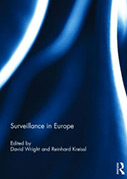Surveillance in Europe

Authors: David Wright and Reinhard Kreissl
Publisher: London; New York: Routledge, 2015. 422p.
Reviewer: Kees Boersma | September 2015
”Is it really that bad?“ one might have wondered, reading through the pages of The Guardian report on the details of the surveillance activities of the US National Security Agency (NSA) based on the documents leaked by Edward Snowden. Yes it is that bad! After watching Snowden’s first TV interview for the German Television Channel NDR in January 2014, many of us might have asked the questions: “What will it mean for us, me? Am I myself subject to scrutiny?” The authors of the book, Surveillance in Europe, edited by David Wright and Reinhard Kreissl aimed to answer these questions by addressing the problem of surveillance from different theoretical, conceptual and disciplinary backgrounds. They not only share an interest in what they call the surveillance society, in which the systematic gathering and storage of personal data is part and parcel of everyday life, but are eager to address the underlying questions about our identity and identification. The question “Who are you?” no longer can be answered by using local knowledge of local actors, as the editors argue in the first chapter, but needs an in-depth understanding of how the surveillance society actually works. This is what the book aims to provide. In particular, the authors are interested in the question whether there is “anything different about surveillance in Europe compared to other countries around the world?” (p. 1).
In the chapter entitled European responses to the Snowden revelations the tone is set for the debate. Although the book is much more than another analysis of a whistleblower fighting the power of the state, the Snowden case is seen by the editors and authors as a watershed moment in the debate on the surveillance society. Since Snowden’s revelations were made public (EU) citizens began realizing that the extent of surveillance in their societies was far greater than they might have imagined. After spelling out the Snowden case, the way the NSA has been collecting meta-data with the software code-named PRISM, and the reactions of citizens and citizen groups, the editors offer a first comprehensive, analytical overview of the European responses to US surveillance practices. For the member states, the authors conclude, the US mass surveillance is monstrously intrusive. It not only endangers individual privacy in Europe – the electronic arms of the NSA are that long – but revelations also show that EU leaders were spied upon as if they were the enemies of the US. Despite the fact that the NSA sought legitimation for their surveillance practices by referring to the threat of terrorism, they surveilled their European “allies” in a range of other spheres, including the economy. At the same time, in the societal debate that followed in Europe, it became clear that the US was not alone in engaging in mass surveillance. Mass monitoring of citizens is a common practice in the EU members’ states: not on the scale or as extensively as the NSA, but serious enough for citizens to be(come) concerned. In the last two decades or so, there have been many books, articles and edited volumes published on surveillance, but it is this that makes the book unique and interesting: it aims at unravelling both the surveillance practices and the reactions in what the authors call resilience in surveillance societies.
The authors of the book are too knowledgeable to be blinkered by the Snowden case. Together they have many years of experience in studying surveillance practices and resilience. Both are contested phenomena. Surveillance for most authors is, as it seems, a powerful window for understanding the increased investments in bureaucracies and techniques to systematically – over longer time-periods – collect, store and use information. They build upon a rich tradition in surveillance studies; many of the authors are member of the Surveillance Studies Network (http://www.surveillance-studies.net/) or have done work within various EU-funded research programs, such as in the COST Action Living in Surveillance Societies (http://www.liss-cost.eu/). The book Surveillance in Europe itself has emerged from the EU funded research project IRISS (Increasing Resilience in Surveillance Societies; http://irissproject.eu/) that ran from 2012-2014. Throughout the book the authors pay attention to the traditional themes in surveillance studies such as function creep, social sorting, panoptic power, workplace and commercial surveillance, privacy and profiling, and to surveillance techniques including fingerprinting, CCTV, body-scans, drones, DNA sampling, and automatic number plate recognition.
In chapters three through seven the contributors introduce specific topics and analytical frameworks to the debate on resilience and surveillance in Europe. The chapters three (written by Kerstin Goos, Michael Friedewald, William Webster and Charles Leleux), four (by Rowena Rodrigues) and five (by Reinhard Kreissl, Clive Norris, Marija Krlic, Leroy Groves and Anthony Amicelle) address respectively the co-evolution of surveillance technologies and practices, the surveillance industry and its commercial side, and the dominant fields where surveillance practices have been implemented for preventing crime and terrorism, in particular law enforcement. Chapters six and seven can be seen as two edited contributions within the edited volume, as they contain sections written by different authors. Together, they offer a broad palette of themes, topics, and perspectives and give an impression of the ongoing debate on surveillance taking place in Europe, and of which the authors are the frontrunners.
Chapter six, by Johann Čas, Stefan Strauss, Anthony Amicelle, Kirstie Ball, Dara Hallinan, Michael Friedewald, and Ivan Szekely, goes into detail on the social and economic costs of surveillance. This chapter examines the direct costs (such as the investments in surveillance systems, the installation and operation of such systems, and their maintenance) and indirect costs (including reduction in innovation due to increased normalized behavior, costs due to the erosion of trust, and costs of juridical errors). The authors come to the – for some dissatisfactory – conclusion that the costs are hard to measure, but they all share the opinion that surveillance techniques lay a heavy economic burden on our shoulders. More importantly, however, is the observation that traditional economic models seem to ignore the more abstract social costs of the surveillance society. After reading this chapter, it is clear that surveillance is a very expensive activity, and that there is thus far a lack of transparency about the costs, which cannot be justified by the benefits, since the latter are hard to measure and, moreover, highly contested.
Chapter seven, with contributions by Charles Raab, Dara Hallinan, Anthony Amicelle, Gemma Galdon Clavell, Antonella Galetta, Paul De Hert and Richard Jones, takes stock of the effects of surveillance on society from a legal point of view. This chapter goes beyond the simplistic idea that our privacy is at stake. Instead, it painstakingly shows that the effects of surveillance are more profound for certain groups in society (i.e. minorities) and that the abilities of individuals to protect themselves are unevenly distributed. This double edged aspect of surveillance underlies the authors’ investigation of its effects from the perspective of European human right laws.
In the first half of chapter 8, the editors give a comprehensive overview of discussions and debates about the surveillance society, concluding: “A surveillance society is one in which the use of surveillance technologies has become virtually ubiquitous and in which such use has become widely (but not uniformly) accepted by the public as endemic and justified by its proponents as necessary for economic, security and other reasons. Even if there are democratic procedures, a surveillance society is one in which there is a parallel system of power exercised by large, oligarchic companies and intelligence agencies over which effective oversight and control are largely illusory” (p. 322). This definition confirms the impression that the authors see surveillance as an important and normal policy element in the modern European societies. They convincingly show that developments in modern information technologies have broadened the scale and scope of surveillance and that surveillance practices have become interwoven with social and political dynamics such as globalization and migration, international terrorism and security, and capitalism and personal consumer information. At the same time, the authors look at the way surveillance can protect society, revealing that they see a dual nature: one cannot paint all surveillance in black and white terms. It is clear, however, that their focus is on the dark side of surveillance and that resistance is needed to cope with the power dimension of the surveillance society.
The parts of the book that open the black box of resilience (and relate it to resistance) are the most interesting ones. Like surveillance, resilience is a contested phenomenon. The editors propose two main paradigms though which resilience can be operationalized: a) resilience in surveillance societies is like a command center that “takes various measures to stimulate social resilience and/or resistance to the increasing prevalence and pervasiveness of surveillance in society” (p. 34), and b) resilience is like “a mesh network: it builds across society, with no central point … resilience becomes viral and out of the hands of any central authority” (p. 34). Since the focus of the book is on both regulation and societal resistance, the authors see a blending of the two paradigms. They have seen practices of self-defense against the surveillance actions and practices of the European states. Against the background of the simplistic metaphor of balancing freedom and security, the editors – on behalf of the authors – propose that a more fundamental reflection upon our contemporary societies (and, in the context of this book, Europe) is needed. They seek a kind of enlightenment and broadening of the public debate on surveillance. As citizens and societal stakeholders, we need to rethink our values, and the social and economic dynamics that fuel processes of political radicalization, risks of a terrorist attacks, migration and mobility: phenomena used by states as excuses to impose intrusive mass surveillance and the politics of exclusion that has led to “fortress Europe.”
The diversity in topics and the different backgrounds of the authors make this a very interesting book and a valuable contribution to the ongoing debate on surveillance, surveillance practices and surveillance societies. Although more visible in one chapter than in the other, resilience is a powerful lens for understanding the way society (and individuals for that matter) responds. Towards the end of the book, and in particular in the final, concluding chapter, the authors’ tone becomes more engaged and – from time to time – activist: “The future surveillance society is likely to be marked by more control, more manipulation of citizens and consumers, more asymmetries of power between corporate and political leaders on the one hand, and the bulk of society on the other. While the future may not be a totalitarian society, it may nevertheless be a tyranny of the minority who control the levers of surveillance, a tyranny with the façade of democracy, no more real than the two-dimensional shop fronts of an old Hollywood western” (p. 369).
Surveillance may have benefits for things such as national security, criminal justice, and emergency response, but the editors conclude that society has become (too) vulnerable to mass surveillance. Their main concern is not that coping and resistance won’t work (indeed there are instances when citizens have successfully resisted surveillance measures), but that the “asymmetry of power between the individual, groups and society as a whole at the one hand, and organizations and state authorities who initiate or implement surveillance measures on the other” (p. 371) will mean that resistance will become less and less likely to succeed. According to the authors, transparency, accountability and legality (“the law”) are not enough to resist mass surveillance and to build democratic structures. Civil society and activist groups are needed to curtail surveillance. The book ends with a reference to the EU Civil Liberties, Justice and Home Affairs Committee (LIBE) that in a 2014 report called on US authorities and (!) EU Member States to prohibit mass surveillance practices and mass processing of personal data.
This book is, as the editors agree, as much a book on the Surveillance of Europe (by the NSA) as Surveillance in Europe (i.e. the title of the book). However, the editors and authors meet their ambition of providing an overview of surveillance politics and practices in Europe, assessing and evaluating the societal impact and raising awareness of the drawbacks of mass surveillance. Not all the chapters are aimed at beginners, but this book deserves the attention of the wider public since it is the first attempt to interconnect issues of surveillance and resilience. It offers citizens insights into what one might find an overwhelming message: we live in surveillance societies in which mass monitoring of our behavior takes place any time and any place. In answering the question “What does it mean for me?” the editors are clear: resistance to mass surveillance is essential to a resilience strategy. The editors and the authors appeal to European societal stakeholders, including citizens, to not slavishly accept the characteristics and consequences of the surveillance society, but instead to show resistance in order to become protected against the arbitrariness and exploitation of surveillance practices. This is an important book.
Kees Boersma is a member of Faculty of Social Sciences, Department of Organization Sciences, VU University Amsterdam – f.k.boersma@vu.nl


